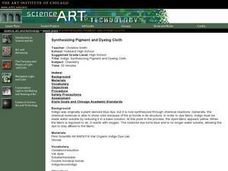Curated OER
Salinity in Mill Creek
Fifth graders use water samples collected at three different locations of Utah's Mill Creek to test salinity of water, hypothesize about salinity levels at each location, record results, and discuss their findings with classmates. ...
Curated OER
Through Thick or Thin!!!
Young scholars differentiate between high and low viscosity. Students collect, graph, and interpret data, then quantitatively measure polymer solids. Young scholars experiment with a household example of an emulsion polymer.
Curated OER
Identifying Elements
Students use diffraction glasses to find similarities and differences between observed spectrum of fluorescent light and an incandescent light They work in groups of 4-6 for the experiment/activity part of this exercise.
Curated OER
The Solar System: Why do we Explore?
Third graders act as scientists. In this property discovery lesson, 3rd graders explore the substance "Oobleck" (cornstarch, water, food coloring). They work in groups to investigate the substance and make observations as a scientist...
Curated OER
Antigens
Students examine antigens including ones found in humans. In this immune lesson students complete several experiments in relation to antigens and antibodies.
Curated OER
Chromatography
Students conduct various experiments on chromatography. In this chemistry lesson, students distinguish among the different types of chromatography methods. They explain how the stationary and mobile phase interact with each other.
Curated OER
Separation of Unknowns in a Liquid
Students identify the different components of a given sample using chromatography. In this chemistry activity, students compare paper and column chromatography. They collect data and construct data tables.
Curated OER
Micro-Magic With Sticky Ions
Students view a video about the formation of precipitates. They complete a worksheet that asks them to identify what makes a compound form and what holds it together.
Curated OER
Synthesizing Pigment and Dyeing Cloth
Students create a synthetic dye and oxidize the dye and record the effects.
Curated OER
A Self Directed Inquiry into the Identification of Unknowns
High schoolers gain experience in designing an experiment and use logic in selecting specific tests for unknowns. Students recognize the use of spreadsheets in helping one to make clear comparisons.
Curated OER
Fish and Oxygen
Students explore what factors affect population dynamics, identify factors affecting fish populations, and use Stella to model how dissolved oxygen affects fish populations.
Curated OER
Selecting Soil Organisms in Compost
Students conduct an experiment to demonstrate that many of the enzyme systems needed to break down society's wastes exist in nature among the decomposers in a compost pile. They culture compost bacteria on starch agar to examine the...
Curated OER
Selecting Soil Organisms in Compost
Students demonstrate that many of the enzyme systems needed to break down--and therefore clean up-society's wastes already exist in nature among the decomposers. They select the best starch-munching organisms by altering the environment...
Curated OER
Separation of Unknowns in a Liquid
Learners identify chromatography as method of separating the components of a liquid. Students discover that dyes are composed of more than one component in achieving a particular color in these lessons on paper chromatography.
Curated OER
Teaching Modeling Water Quality
Students explore the basics of interpreting RUSS temperature and oxygen profile data. They are introduced to the Geographic Information Systems (GIS), particularly with respect to interpreting maps.
















